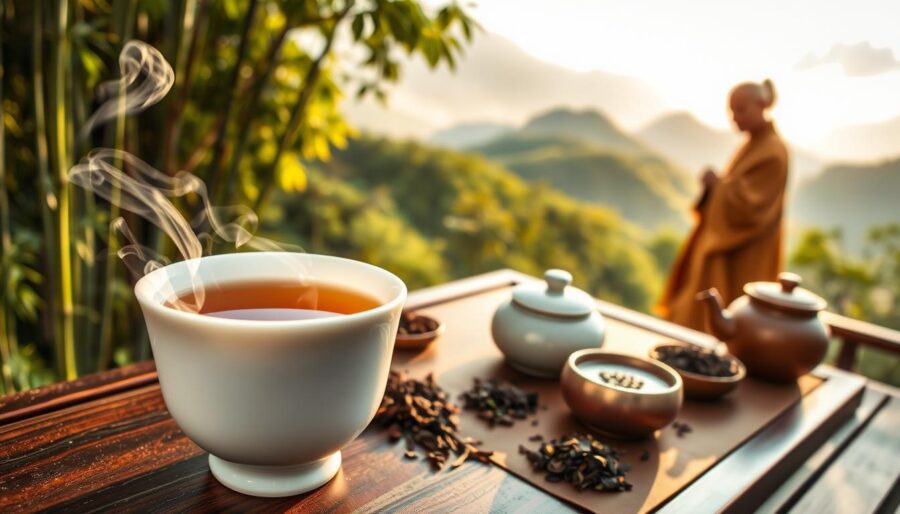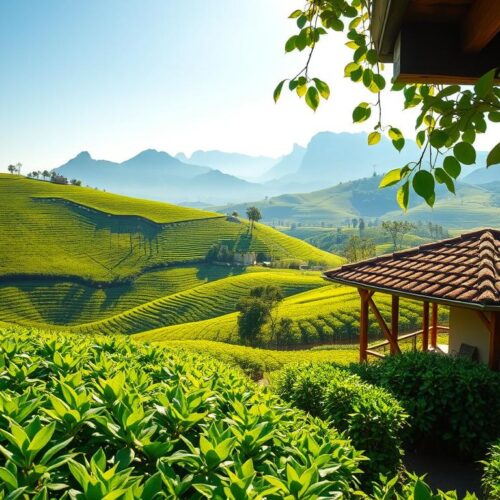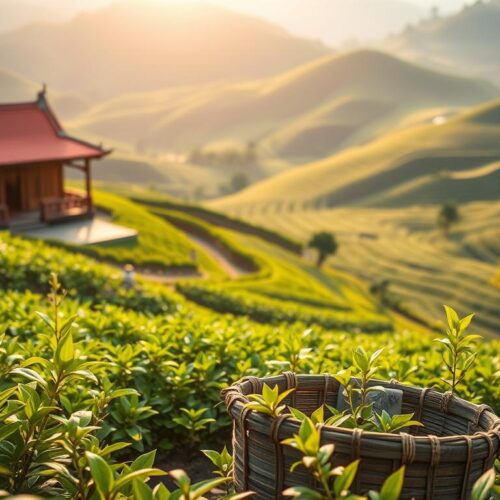Starting a journey through tea tasting in China is more than exploring flavors. It’s a journey into a culture that loves this ancient drink. This guide shows the fascinating world of Chinese tea, its history, and its many types. By traveling for tea in China, you’ll learn to enjoy the unique tastes of different teas. You’ll also see the big role tea has in daily life. Get ready to taste, enjoy, and dive into the traditions that make Chinese tea tasting special.
Understanding the Rich History of Tea in China
The history of tea in China is long, stretching back thousands of years. It started as a simple medicinal drink. Early writings from the Shang Dynasty show people first used tea for health reasons. Over centuries, tea became much more than just a health drink. It turned into a sign of warmth and respect in tea traditions.
Tea’s journey through time saw it gain different meanings in various dynasties. In the Tang Dynasty, tea became widely loved. This led to the creation of tea ceremonies. These ceremonies aren’t just routines. They’re special moments that show the strong bond between tea and Chinese culture.
The Silk Road was key in taking tea culture far beyond China. This famous trade path allowed tea to reach faraway places. It made tea a key part of drinks around the world. The spread of tea proves its versatility. It also shows how tea brings people together across different cultures.
Different Types of Chinese Tea
Chinese tea has many flavors and types, each with its own special qualities. Learning about these types makes tea tasting more enjoyable. You can explore different methods that make each tea unique.
Green tea is well-loved for its fresh taste. It’s barely oxidized, keeping the leaves’ true flavor. Longjing, or Dragon Well, is a great example of green tea’s bright taste.
Oolong tea is known for its rich and varied tastes. Its leaves are partly oxidized. This creates flavors that range from floral to toasty. Wuyi Rock Oolong shows just how diverse oolong tea can be.
Pu-erh tea has a deep history and flavor. It’s aged and known for its earthy taste. A special fermentation process makes pu-erh tea get better with time. This gives it a complex flavor.
The Art of Tea Tasting
The art of tea tasting is more than just drinking tea. It is a deep sensory experience. It includes your taste, smell, and vision. Each tea has its own unique traits. These traits ask you to use certain skills to fully enjoy the tea.
Begin your tea journey by paying attention to these:
- Aroma: Smell the tea before you taste it. The aroma can hint at the tea’s flavor.
- Color: Look at the tea’s color. Its shade shows how much it oxidized and affects taste.
- Flavor: Savor the tea in your mouth. Try to find different tastes like flower, earth, or fruit.
- Temperature: Drink the tea at the right warmth. Wrong temperature can hide its real taste.
- Steeping Time: Watch how long you steep it. Too long makes it bitter, too short makes it weak.
- Equipment: Use the right tools for brewing. They help get the best flavor from the leaves.
Pay attention to these details, and you’ll notice the small differences in teas. With practice, you’ll get better at tasting. Each tea tasting will become a fun discovery of flavors.
Preparing for Your Tea Tasting Journey
Getting ready for a tea tasting journey needs some planning. Start by getting the right tea tools like quality teapots, cups, and filters. These items will make your tea brewing better and your tea tasting more fun.
Before you begin your tea journey in China, think about which places you want to see. China offers a wide variety of teas, each with its own taste and way of making. Learning about these areas will help you decide which teas to try.
Knowing how to prepare tea is key for a good tasting experience. Use filtered water for a pure taste. Also, be mindful of how long you steep each tea. Different teas taste best at certain temperatures and times. Getting this right will make your tea taste much better.
| Tea Type | Water Temperature (°F) | Steeping Time (minutes) |
|---|---|---|
| Green Tea | 175-185 | 2-3 |
| Oolong Tea | 185-205 | 3-5 |
| Black Tea | 200-212 | 3-5 |
| White Tea | 160-185 | 4-5 |
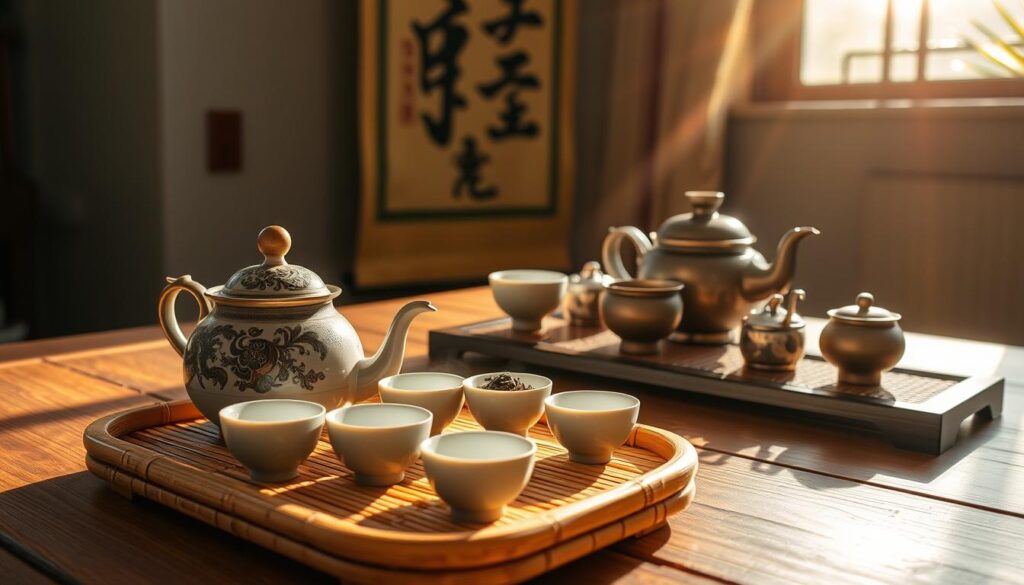
Popular Tea Regions in China
China has many tea regions, each famous for its unique tastes and growing methods. As you visit these places, you’ll see how old traditions affect the tea made. Important tea areas in China include:
- Yunnan: Known for its fertile soil and good climate, Yunnan is where the famous pu-erh tea comes from. This tea is liked for its strong, earthy flavor.
- Zhejiang: This area gives us the beloved Longjing or Dragon Well tea. It’s a green tea with a slight sweet taste and a hint of nutty scent.
- Fujian: Famous for top-notch oolong teas, Fujian’s teas are known for their floral smells and complex tastes.
Going to these tea regions in China does more than just deepen your love for tea. It also lets you experience the local ways and traditions about tea. Moreover, by visiting different tea farms in China, you get to see how tea is made up close. This experience teaches you why each region’s tea is unique.
How to Taste Tea like a Pro
Start tasting tea like a pro with a clean palate. Choose the right tea ware to make the experience better. First, look at the dry leaves—notice their color and feel. This step tells a lot about the tea’s quality.
Next, smell the dry leaves and then the tea after brewing. The aroma is key as it adds a lot to the taste.
When you taste the tea, sip it slowly. Let the tea go all over your palate. Pay attention to the aftertaste and the flavors that stay. Each tea brings different feelings, so be ready for new tastes.
Using these tips will make you better at understanding tea.
It’s a good idea to keep a tasting journal. Write down your thoughts on different teas, their flavors, and what you like. This will help you get better at tasting tea over time.
Pairing Food with Tea
Improving your dining experience can be as simple as pairing food with tea. You enhance the taste of both by matching tea flavors with specific dishes. For example, jasmine tea goes well with light Asian dishes like sushi or steamed dumplings. Its floral notes can make these meals even more enjoyable by adding a delightful balance.
A strong pu-erh tea, on the other hand, is perfect with savory meat dishes. Its earthy taste mixes well with the flavors of roasted duck or beef. This creates a pleasing contrast that’s sure to satisfy your taste buds.
Knowing how tea and food flavors work together can make your meals better. Here are some great combinations to try:
- Green Tea – Great with salads and seafood, as it brings out their natural tastes.
- Oolong Tea – Best with grilled meats; it adds depth to the meal’s flavors.
- Herbal Tea – Ideal with desserts, providing a calm balance to sweetness.
Trying out these pairings can deepen your love for tea and food. It’s fun to explore flavors and create unforgettable eating experiences. Enjoy your journey into the world of food and tea.
Health Benefits of Tea Consumption
Tea drinking has become widely recognized for its health perks, especially in tea-loving cultures. With varieties like green, black, and herbal tea, each offers unique health benefits. This is thanks to their different antioxidants and bioactive components. Knowing these advantages can make you value tea more and encourage a thoughtful tea routine.
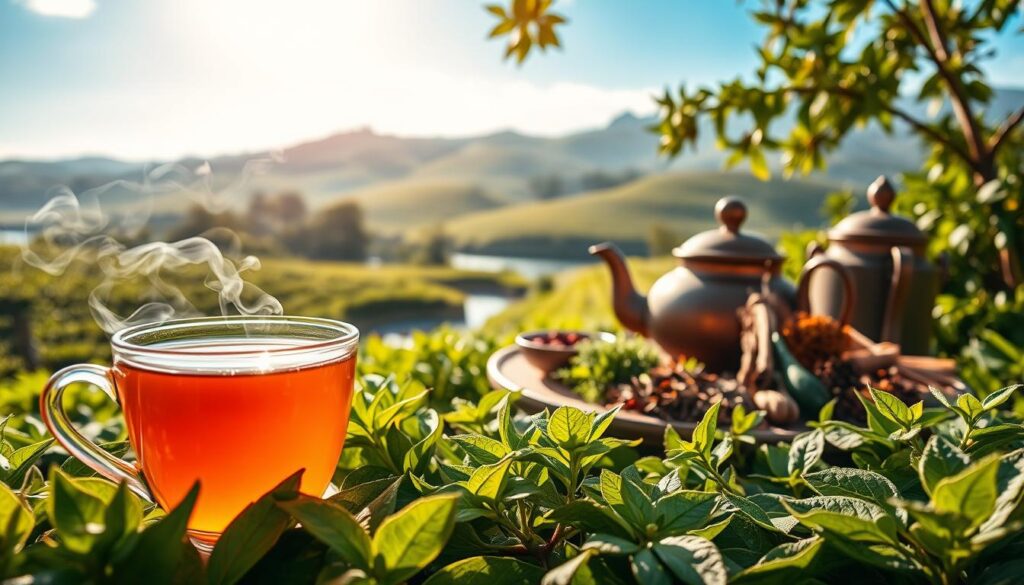
Take green tea, for example – it’s great for digestion and boosting metabolism. Black tea is known to sharpen the mind and support heart health. Drinking herbal teas can be a soothing way to relax and help with digestion. Below, you’ll find some benefits that tea drinking might bring:
- Improved digestion and gut health
- Enhanced cognitive function and focus
- Stronger immune system support
- Antioxidant properties that combat free radicals
- Reduced risk of chronic diseases
By adding various teas to your day, you can enjoy their health advantages and a rich taste. As you dive into tea culture, cherish each moment and think about how it’s good for you.
| Type of Tea | Health Benefits |
|---|---|
| Green Tea | Boosts metabolism, improves digestion |
| Black Tea | Enhances mental clarity, promotes heart health |
| Herbal Tea | Aids relaxation, supports digestion |
| Oolong Tea | May aid in weight management, lowers cholesterol |
The Role of Tea in Chinese Culture
Tea is very important in Chinese culture. It symbolizes hospitality, respect, and spirituality. The traditions of tea culture show its value beyond just drinking it. Traditional tea ceremonies, which are an art form, stress the careful making and enjoying of tea. They also help people connect with each other.
Tea plays a big role during important celebrations and life events. At weddings, births, or major holidays, tea is always present. It symbolizes togetherness and happiness. Tea connects families and friends, strengthening social ties during key moments.
The entire process of tea, from growing it to serving it, reflects deep cultural values like harmony, patience, and respect. Understanding tea’s role helps us value the drink and the rich heritage it brings with each sip.
Tea’s importance goes beyond being a simple drink. It’s a key part of traditions, customs, and philosophies. It helps shape the identity of individuals and communities.
| Aspect | Significance |
|---|---|
| Symbol of Hospitality | Guests are often welcomed with tea, reflecting warmth and respect. |
| Ceremonial Importance | Tea ceremonies demonstrate meticulous craftsmanship and cultural heritage. |
| Social Connector | Tea serves as a medium for fostering relationships and community bonds. |
| Celebrations and Rituals | Integral part of weddings, festivals, and significant life events. |
| Cultural Values | Emphasizes patience, harmony, and respect in everyday interactions. |
Visiting Tea Houses in China
Exploring tea houses in China is a unique chance for tea lovers. These places offer a calm space to relax and try various exceptional teas. When you visit, you will experience tea tastings prepared by experts. They teach about the flavors and histories of each tea.
In China, tea houses are everywhere, each with its own special feel and offerings. When you visit, you’ll find these experiences enriching:
- Serene Environment: Enjoy a peaceful setting perfect for relaxation and contemplation.
- Diverse Tea Selection: Savor traditional and modern teas, ranging from delicate green teas to robust black varieties.
- Expert Guidance: Benefit from the expertise of staff who can share the origins and brewing methods of different teas.
- Cultural Interaction: Engage in conversation with fellow tea lovers and experience the communal aspect of tea drinking in China.
- Artistic Presentation: Appreciate the artistry involved in tea brewing and serving, reflecting China’s cultural heritage.
Overall, tea houses in China turn tea tasting into a cultural journey. This journey deepens your love for this beloved drink.
The Future of Tea in China
The future of tea in China blends old traditions with new changes. You’ll see a big interest worldwide that helps shape what tea looks like now. People want teas that are not only good but also real and organic.
Tea makers are now focusing on keeping our planet safe. They adopt green ways to make sure tea can be enjoyed by future people. This effort isn’t just about the earth. It also makes the tea better. Customers now care more about where their tea comes from.
- Organic Tea Cultivation: Producers are adopting organic methods to meet consumer demand for healthier options.
- Flavored and Specialty Teas: There is a growing interest in unique flavors and blends, appealing to a diverse audience.
- Innovative Packaging Solutions: Eco-friendly packaging techniques are gaining traction, reflecting consumer values.
- Digital Marketing Strategies: Brands are leveraging social media and online platforms to connect with a global audience.
| Trend | Description | Impact |
|---|---|---|
| Organic Tea Cultivation | Shifting towards chemical-free farming techniques | Increased consumer trust and acceptance |
| Flavored and Specialty Teas | Offering unique taste experiences beyond traditional options | Diverse market expansion and niche opportunities |
| Sustainable Practices | Adopting environmentally friendly methods in production | Long-term viability and brand loyalty |
| Digital Marketing | Utilizing online channels for brand awareness and engagement | Wider reach and enhanced consumer interaction |
Looking ahead, the future of tea in China is full of opportunities, led by a need for sustainable choices and changing tastes. As you move through this lively market, keep up with the changes. They will define how we enjoy tea for many years.
Conclusion: Your Tea Tasting Adventure Awaits
As you end your journey into Chinese tea, you’re now ready for a fantastic tea tasting adventure. This guide taught you about tea’s rich history, its different types, and its meaning in China. Each sip connects you to centuries of tradition, taste, and pride.
Your Chinese tea journey is more than just tasting; it’s about diving into a world where every cup has a story. Going to famous tea areas like Yunnan, Fujian, and Zhejiang lets you explore unique flavors. Meeting local crafters and tea experts will make you appreciate tea more, making drinking it better.
No matter if you’re starting or have been tasting tea for a while, your adventure will be full of new discoveries. Enjoy every moment and let your senses explore the beautiful flavors and cultures in each tea house and on every hillside. Your tea tasting journey is just starting. Let it reveal its fragrant wonders.

